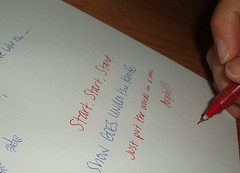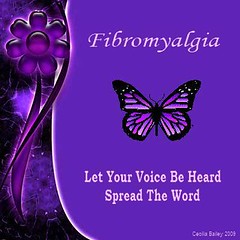 Image by tray via Flickr
Image by tray via FlickrSo last week I discussed doing a fibromyalgia time study to help you find your baseline level of functioning. This week I am wondering what you think of that form and how your time studies are coming along.
By the way, have you stopped and rewarded yourself for investing the time and energy into becoming a better fibromyalgia scientist/detective? After all, treating yourself to something special for all your small, baby steps helps maintain your motivation over the long haul.
This week I am providing you with another form that will help you pull everything together and map your energy boundaries. Take a look at the form I created below:
If you like what you see, you can download a copy of the form for your own personal use.
If you have your three days worth of time studies, completing this energy boundary map will be very easy. Just grab a calculator and add up the time you spent doing physical, mental and social activities. When you are done, you will have a clearer picture of how much energy you have on an average day and where you allocate that energy.
Then look at your comfort zones and your average pain and fatigue levels and decide if this is where you want to be.
If the answer is yes, then woohoo!
If the answer is maybe or no, it's time to take stock and consider making some changes. Using this form, you can identify the areas where you'll want to modify, simplify, ask for help, cut back and/or say no. You might also see the benefits of adding more rest or sleep to your schedule, tackling stressors, minimizing triggers for sensitivities, making more time for fun or talking to someone about your issues for advice and support.
This map of your energy boundaries lets you see the thin line that separates good days from bad days. If you can see the line, then you know when you are about to cross it and land into higher symptoms/lower functioning territory. Seeing the line will help you make better choices about how you are going to allocate your precious and limited energy each day.
Combined with the time study data, this completed form gives you specific, concrete information about your level of functioning that you can share with your health care team. Just think, at your next doctor's appointment you can say, "I am having problems doing (x,y or z). This activity increases my pain/fatigue. Is there anything we can do to address this, maybe with medication, lifestyle changes or physical/occupational therapy, so I can have some improvement in this area?"
Next week I'm wrapped up this month's topic by sharing some more ideas on how you can use forms and logs to do things like root out the cause of specific problems or track your response when you make changes to your routine, medications or lifestyle.

















![Reblog this post [with Zemanta]](http://img.zemanta.com/reblog_b.png?x-id=c0a35b20-f772-4dae-8baa-b568a8e325f9)

![Reblog this post [with Zemanta]](http://img.zemanta.com/reblog_b.png?x-id=a85090ee-f527-4286-a058-cb9b64b530ef)

![Reblog this post [with Zemanta]](http://img.zemanta.com/reblog_e.png?x-id=19f6ec3b-c079-4af1-bc5c-030531948002)
![Reblog this post [with Zemanta]](http://img.zemanta.com/reblog_b.png?x-id=20dab255-00b9-4a9a-870b-b3f87c84b653)

![Reblog this post [with Zemanta]](http://img.zemanta.com/reblog_b.png?x-id=91ae0724-3c4b-47f2-a955-563c9adc7139)


![Reblog this post [with Zemanta]](http://img.zemanta.com/reblog_b.png?x-id=991646bf-3e69-4913-8553-e6a70054e330)



![Reblog this post [with Zemanta]](http://img.zemanta.com/reblog_b.png?x-id=6e3fcdd9-83fd-4227-aec2-262e06b85493)








![Reblog this post [with Zemanta]](http://img.zemanta.com/reblog_b.png?x-id=92f239dd-b027-4493-9ab6-b54a0de02ede)